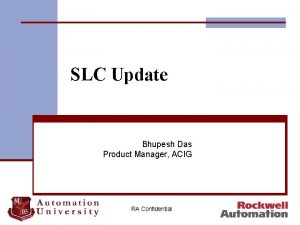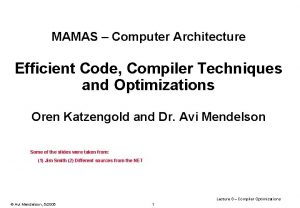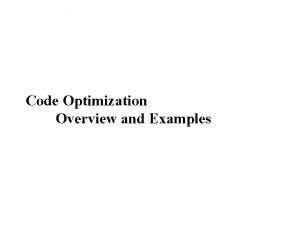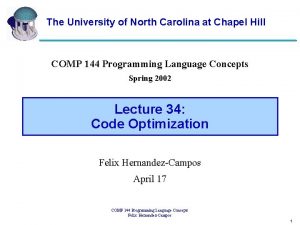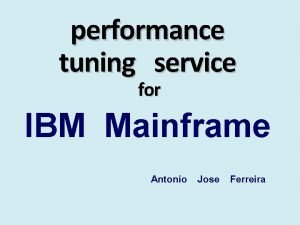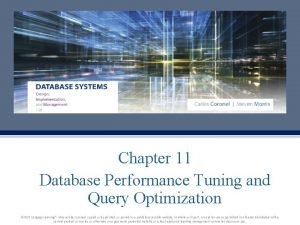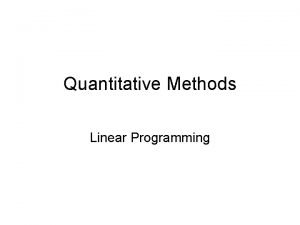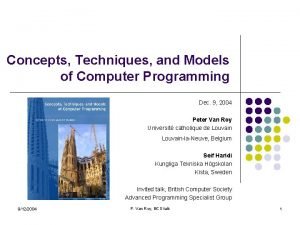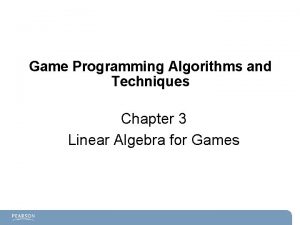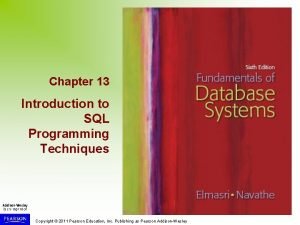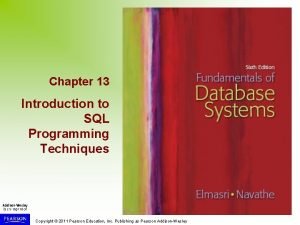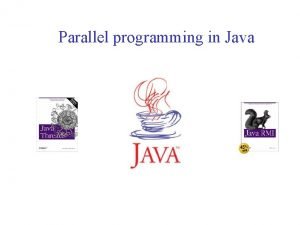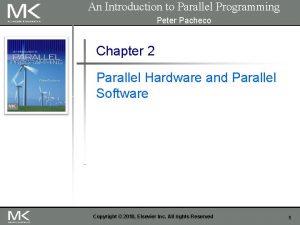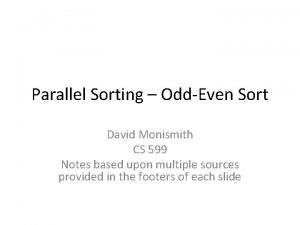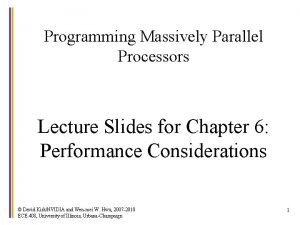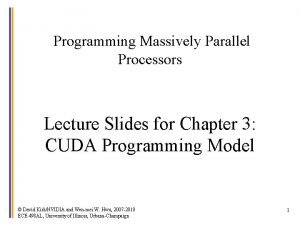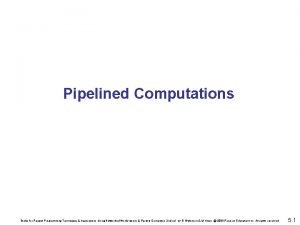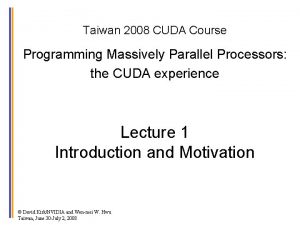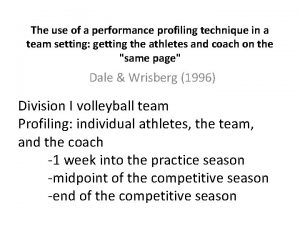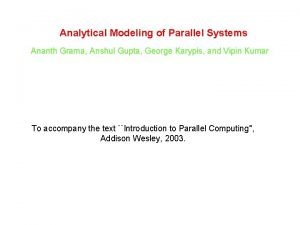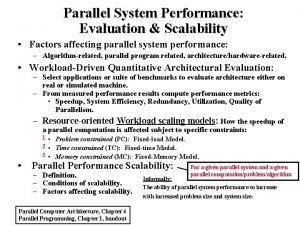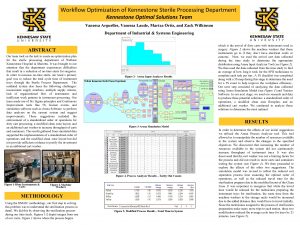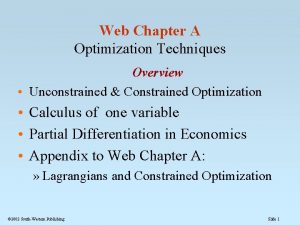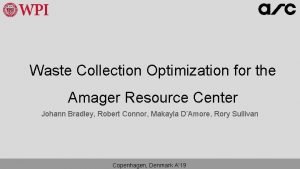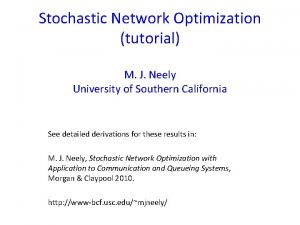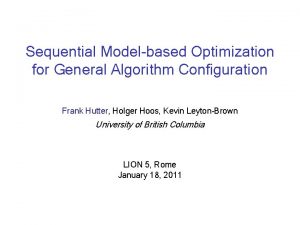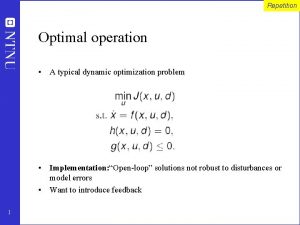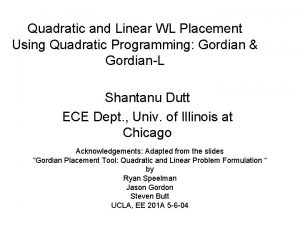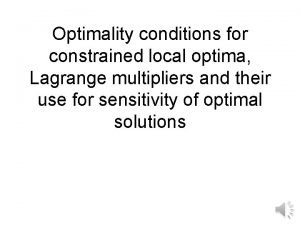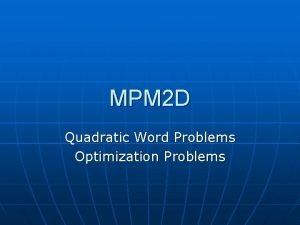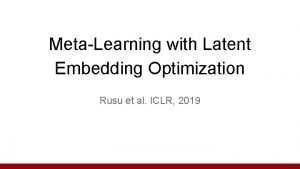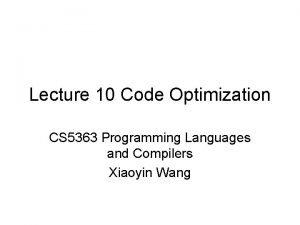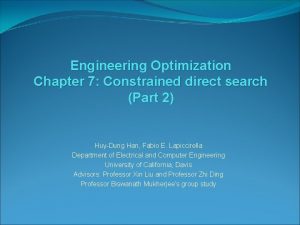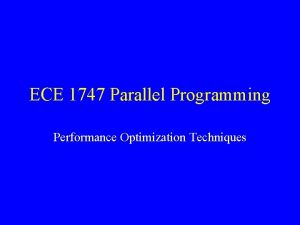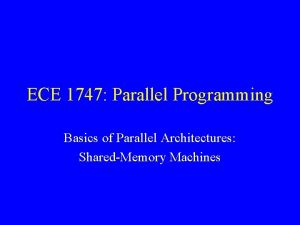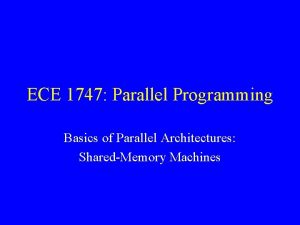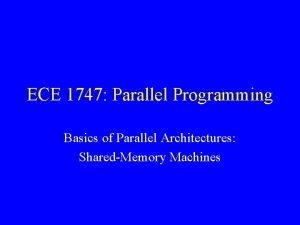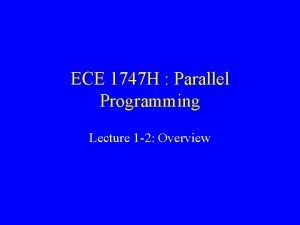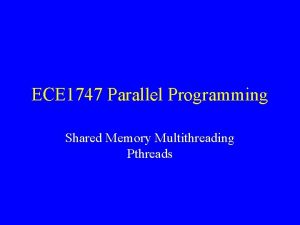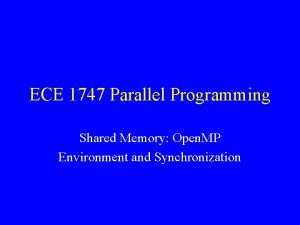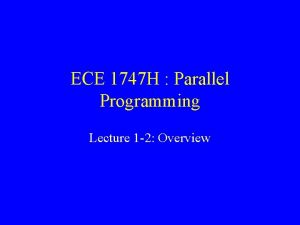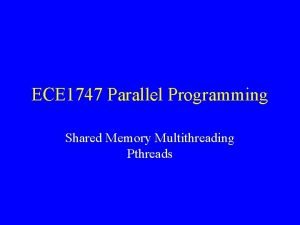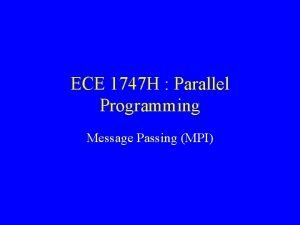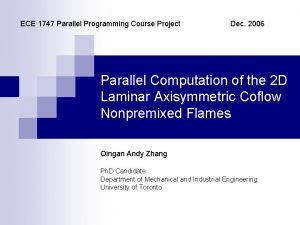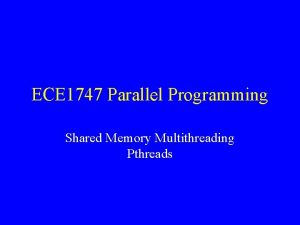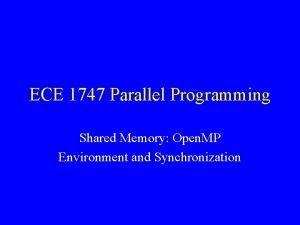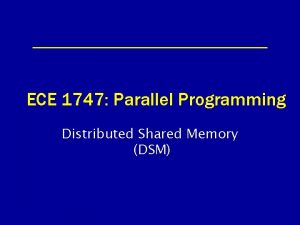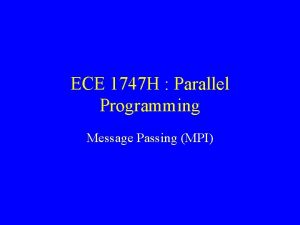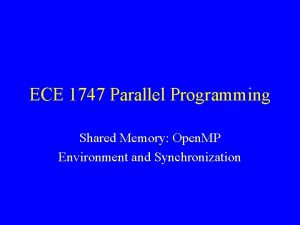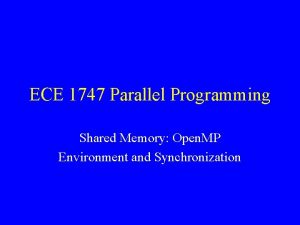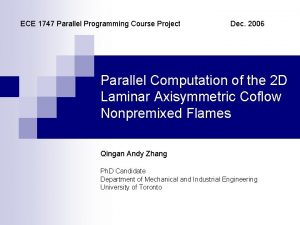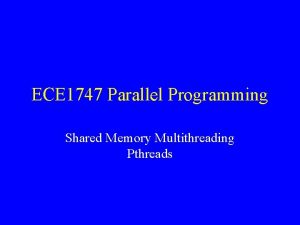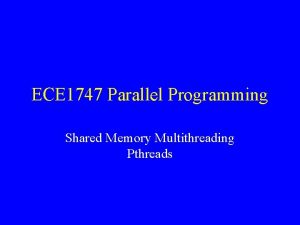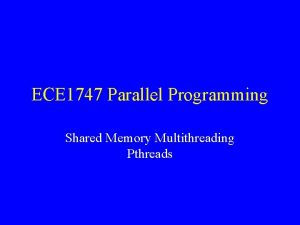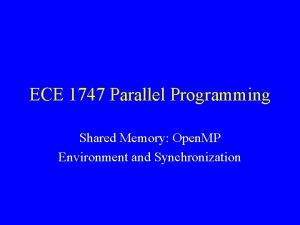ECE 1747 Parallel Programming Machineindependent Performance Optimization Techniques



![Example 1 for( i=0; i<n; i++ ) { tmp = a[i]; a[i] = b[i]; Example 1 for( i=0; i<n; i++ ) { tmp = a[i]; a[i] = b[i];](https://slidetodoc.com/presentation_image/adab0c38b6611d12736404fa84195766/image-4.jpg)

![Example 2 for( i=0, sum=0; i<n; i++ ) sum += a[i]; • Dependence on Example 2 for( i=0, sum=0; i<n; i++ ) sum += a[i]; • Dependence on](https://slidetodoc.com/presentation_image/adab0c38b6611d12736404fa84195766/image-6.jpg)

![Example 3 for( i=0, index=0; i<n; i++ ) { index += i; a[i] = Example 3 for( i=0, index=0; i<n; i++ ) { index += i; a[i] =](https://slidetodoc.com/presentation_image/adab0c38b6611d12736404fa84195766/image-8.jpg)
![Induction Variable Elimination #pragma omp parallel for( i=0, index=0; i<n; i++ ) { a[i] Induction Variable Elimination #pragma omp parallel for( i=0, index=0; i<n; i++ ) { a[i]](https://slidetodoc.com/presentation_image/adab0c38b6611d12736404fa84195766/image-9.jpg)
![Example 4 for( i=0, index=0; i<n; i++ ) { index += f(i); b[i] = Example 4 for( i=0, index=0; i<n; i++ ) { index += f(i); b[i] =](https://slidetodoc.com/presentation_image/adab0c38b6611d12736404fa84195766/image-10.jpg)
![Loop Splitting for( i=0; i<n; i++ ) { index[i] += f(i); } #pragma omp Loop Splitting for( i=0; i<n; i++ ) { index[i] += f(i); } #pragma omp](https://slidetodoc.com/presentation_image/adab0c38b6611d12736404fa84195766/image-11.jpg)



![Example 6 #pragma omp parallel for(i=0; i<n; i++ ) a[i] = b[i]; #pragma omp Example 6 #pragma omp parallel for(i=0; i<n; i++ ) a[i] = b[i]; #pragma omp](https://slidetodoc.com/presentation_image/adab0c38b6611d12736404fa84195766/image-15.jpg)
![Loop Fusion #pragma omp parallel for(i=0; i<n; i++ ) { a[i] = b[i]; c[i] Loop Fusion #pragma omp parallel for(i=0; i<n; i++ ) { a[i] = b[i]; c[i]](https://slidetodoc.com/presentation_image/adab0c38b6611d12736404fa84195766/image-16.jpg)



![Another Special Case of Loop Splitting for( p=head, count=0; p!=NULL; p=p->next, count++); count[i] = Another Special Case of Loop Splitting for( p=head, count=0; p!=NULL; p=p->next, count++); count[i] =](https://slidetodoc.com/presentation_image/adab0c38b6611d12736404fa84195766/image-20.jpg)

![Example 9 for( i=0, wrap=n; i<n; i++ ) { b[i] = a[i] + a[wrap]; Example 9 for( i=0, wrap=n; i<n; i++ ) { b[i] = a[i] + a[wrap];](https://slidetodoc.com/presentation_image/adab0c38b6611d12736404fa84195766/image-22.jpg)
![Loop Peeling b[0] = a[0] + a[n]; #pragma omp parallel for( i=1; i<n; i++ Loop Peeling b[0] = a[0] + a[n]; #pragma omp parallel for( i=1; i<n; i++](https://slidetodoc.com/presentation_image/adab0c38b6611d12736404fa84195766/image-23.jpg)
![Example 10 for( i=0; i<n; i++ ) a[i+m] = a[i] + b[i]; • Dependence Example 10 for( i=0; i<n; i++ ) a[i+m] = a[i] + b[i]; • Dependence](https://slidetodoc.com/presentation_image/adab0c38b6611d12736404fa84195766/image-24.jpg)

















![Molecular Dynamics (continued) for each molecule i number of nearby molecules count[i] array of Molecular Dynamics (continued) for each molecule i number of nearby molecules count[i] array of](https://slidetodoc.com/presentation_image/adab0c38b6611d12736404fa84195766/image-42.jpg)
















![Example 1 for( i=0; i<n; i++ ) for( j=0; j<n; j++ ) grid[i][j] = Example 1 for( i=0; i<n; i++ ) for( j=0; j<n; j++ ) grid[i][j] =](https://slidetodoc.com/presentation_image/adab0c38b6611d12736404fa84195766/image-59.jpg)
![Example 2 for( j=0; j<n; j++ ) for( i=0; i<n; i++ ) grid[i][j] = Example 2 for( j=0; j<n; j++ ) for( i=0; i<n; i++ ) grid[i][j] =](https://slidetodoc.com/presentation_image/adab0c38b6611d12736404fa84195766/image-60.jpg)
![Example 3 for( i=0; i<n; i++ ) for( j=0; j<n; j++ ) temp[i][j] = Example 3 for( i=0; i<n; i++ ) for( j=0; j<n; j++ ) temp[i][j] =](https://slidetodoc.com/presentation_image/adab0c38b6611d12736404fa84195766/image-61.jpg)
![Access to grid[i][j] • First time grid[i][j] is used: temp[i-1, j]. • Second time Access to grid[i][j] • First time grid[i][j] is used: temp[i-1, j]. • Second time](https://slidetodoc.com/presentation_image/adab0c38b6611d12736404fa84195766/image-62.jpg)











![Example: Parallelization Ignoring Locality for( i=0; i<n; i++ ) a[i] = i; #pragma omp Example: Parallelization Ignoring Locality for( i=0; i<n; i++ ) a[i] = i; #pragma omp](https://slidetodoc.com/presentation_image/adab0c38b6611d12736404fa84195766/image-74.jpg)
![Example: Taking Locality into Account #pragma omp parallel for( i=0; i<n; i++ ) a[i] Example: Taking Locality into Account #pragma omp parallel for( i=0; i<n; i++ ) a[i]](https://slidetodoc.com/presentation_image/adab0c38b6611d12736404fa84195766/image-75.jpg)


- Slides: 77

ECE 1747 Parallel Programming Machine-independent Performance Optimization Techniques

Returning to Sequential vs. Parallel • Sequential execution time: t seconds. • Startup overhead of parallel execution: t_st seconds (depends on architecture) • (Ideal) parallel execution time: t/p + t_st. • If t/p + t_st > t, no gain.

General Idea • Parallelism limited by dependences. • Restructure code to eliminate or reduce dependences. • Sometimes possible by compiler, but good to know how to do it by hand.
![Example 1 for i0 in i tmp ai ai bi Example 1 for( i=0; i<n; i++ ) { tmp = a[i]; a[i] = b[i];](https://slidetodoc.com/presentation_image/adab0c38b6611d12736404fa84195766/image-4.jpg)
Example 1 for( i=0; i<n; i++ ) { tmp = a[i]; a[i] = b[i]; b[i] = tmp; } • Dependence on tmp.

Scalar Privatization #pragma omp parallel for private(tmp) for( i=0; i<n; i++ ) { tmp = a[i]; a[i] = b[i]; b[i] = tmp; } • Dependence on tmp is removed.
![Example 2 for i0 sum0 in i sum ai Dependence on Example 2 for( i=0, sum=0; i<n; i++ ) sum += a[i]; • Dependence on](https://slidetodoc.com/presentation_image/adab0c38b6611d12736404fa84195766/image-6.jpg)
Example 2 for( i=0, sum=0; i<n; i++ ) sum += a[i]; • Dependence on sum.

Reduction #pragma omp parallel for reduction(+, sum) for( i=0, sum=0; i<n; i++ ) sum += a[i]; • Dependence on sum is removed.
![Example 3 for i0 index0 in i index i ai Example 3 for( i=0, index=0; i<n; i++ ) { index += i; a[i] =](https://slidetodoc.com/presentation_image/adab0c38b6611d12736404fa84195766/image-8.jpg)
Example 3 for( i=0, index=0; i<n; i++ ) { index += i; a[i] = b[index]; } • Dependence on index. • Induction variable: can be computed from loop variable.
![Induction Variable Elimination pragma omp parallel for i0 index0 in i ai Induction Variable Elimination #pragma omp parallel for( i=0, index=0; i<n; i++ ) { a[i]](https://slidetodoc.com/presentation_image/adab0c38b6611d12736404fa84195766/image-9.jpg)
Induction Variable Elimination #pragma omp parallel for( i=0, index=0; i<n; i++ ) { a[i] = b[i*(i+1)/2]; } • Dependence removed by computing the induction variable.
![Example 4 for i0 index0 in i index fi bi Example 4 for( i=0, index=0; i<n; i++ ) { index += f(i); b[i] =](https://slidetodoc.com/presentation_image/adab0c38b6611d12736404fa84195766/image-10.jpg)
Example 4 for( i=0, index=0; i<n; i++ ) { index += f(i); b[i] = g(a[index]); } • Dependence on induction variable index, but no closed formula for its value.
![Loop Splitting for i0 in i indexi fi pragma omp Loop Splitting for( i=0; i<n; i++ ) { index[i] += f(i); } #pragma omp](https://slidetodoc.com/presentation_image/adab0c38b6611d12736404fa84195766/image-11.jpg)
Loop Splitting for( i=0; i<n; i++ ) { index[i] += f(i); } #pragma omp parallel for( i=0; i<n; i++ ) { b[i] = g(a[index[i]]); } • Loop splitting has removed dependence.

Example 5 for( k=0; k<n; k++ ) for( i=0; i<n; i++ ) for( j=0; j<n; j++ ) a[i][j] += b[i][k] + c[k][j]; • Dependence on a[i][j] prevents k-loop parallelization. • No dependencies carried by i- and j-loops.

Example 5 Parallelization for( k=0; k<n; k++ ) #pragma omp parallel for( i=0; i<n; i++ ) for( j=0; j<n; j++ ) a[i][j] += b[i][k] + c[k][j]; • We can do better by reordering the loops.

Loop Reordering #pragma omp parallel for( i=0; i<n; i++ ) for( j=0; j<n; j++ ) for( k=0; k<n; k++ ) a[i][j] += b[i][k] + c[k][j]; • Larger parallel pieces of work.
![Example 6 pragma omp parallel fori0 in i ai bi pragma omp Example 6 #pragma omp parallel for(i=0; i<n; i++ ) a[i] = b[i]; #pragma omp](https://slidetodoc.com/presentation_image/adab0c38b6611d12736404fa84195766/image-15.jpg)
Example 6 #pragma omp parallel for(i=0; i<n; i++ ) a[i] = b[i]; #pragma omp parallel for( i=0; i<n; i++ ) c[i] = b[i]^2; • Make two parallel loops into one.
![Loop Fusion pragma omp parallel fori0 in i ai bi ci Loop Fusion #pragma omp parallel for(i=0; i<n; i++ ) { a[i] = b[i]; c[i]](https://slidetodoc.com/presentation_image/adab0c38b6611d12736404fa84195766/image-16.jpg)
Loop Fusion #pragma omp parallel for(i=0; i<n; i++ ) { a[i] = b[i]; c[i] = b[i]^2; } • Reduces loop startup overhead.

Example 7: While Loops while( *a) { process(a); a++; } • The number of loop iterations is unknown.

Special Case of Loop Splitting for( count=0, p=a; p!=NULL; count++, p++ ); #pragma omp parallel for( i=0; i<count; i++ ) process( a[i] ); • Count the number of loop iterations. • Then parallelize the loop.

Example 8: Linked Lists for(p=head; !p; p=p->next ) /* Assume process does not affect linked list */ process(p); • Dependence on p
![Another Special Case of Loop Splitting for phead count0 pNULL ppnext count counti Another Special Case of Loop Splitting for( p=head, count=0; p!=NULL; p=p->next, count++); count[i] =](https://slidetodoc.com/presentation_image/adab0c38b6611d12736404fa84195766/image-20.jpg)
Another Special Case of Loop Splitting for( p=head, count=0; p!=NULL; p=p->next, count++); count[i] = f(count, omp_get_numthreads()); start[0] = head; for( i=0; i< omp_get_numthreads(); i++ ) { for( p=start[i], cnt=0; cnt<count[i]; p=p->next); start[i+1] = p->next; }

Another Special Case of Loop Splitting #pragma omp parallel sections for( i=0; i< omp_get_numthreads(); i++ ) #pragma omp section for(p=start[i]; p!=start[i+1]; p=p->next) process(p);
![Example 9 for i0 wrapn in i bi ai awrap Example 9 for( i=0, wrap=n; i<n; i++ ) { b[i] = a[i] + a[wrap];](https://slidetodoc.com/presentation_image/adab0c38b6611d12736404fa84195766/image-22.jpg)
Example 9 for( i=0, wrap=n; i<n; i++ ) { b[i] = a[i] + a[wrap]; wrap = i; } • Dependence on wrap. • Only first iteration causes dependence.
![Loop Peeling b0 a0 an pragma omp parallel for i1 in i Loop Peeling b[0] = a[0] + a[n]; #pragma omp parallel for( i=1; i<n; i++](https://slidetodoc.com/presentation_image/adab0c38b6611d12736404fa84195766/image-23.jpg)
Loop Peeling b[0] = a[0] + a[n]; #pragma omp parallel for( i=1; i<n; i++ ) { b[i] = a[i] + a[i-1]; }
![Example 10 for i0 in i aim ai bi Dependence Example 10 for( i=0; i<n; i++ ) a[i+m] = a[i] + b[i]; • Dependence](https://slidetodoc.com/presentation_image/adab0c38b6611d12736404fa84195766/image-24.jpg)
Example 10 for( i=0; i<n; i++ ) a[i+m] = a[i] + b[i]; • Dependence if m<n.

Another Case of Loop Peeling if(m>n) { #pragma omp parallel for( i=0; i<n; i++ ) a[i+m] = a[i] + b[i]; } else { … cannot be parallelized }

Summary • Reorganize code such that – dependences are removed or reduced – large pieces of parallel work emerge – loop bounds become known –… • Code can become messy … there is a point of diminishing returns.

Factors that Determine Speedup • Characteristics of parallel code – granularity – load balance – locality – communication and synchronization

Granularity • Granularity = size of the program unit that is executed by a single processor. • May be a single loop iteration, a set of loop iterations, etc. • Fine granularity leads to: – (positive) ability to use lots of processors – (positive) finer-grain load balancing – (negative) increased overhead

Granularity and Critical Sections • Small granularity => more processors => more critical section accesses => more contention.

Issues in Performance of Parallel Parts • • Granularity. Load balance. Locality. Synchronization and communication.

Load Balance • Load imbalance = different in execution time between processors between barriers. • Execution time may not be predictable. – Regular data parallel: yes. – Irregular data parallel or pipeline: perhaps. – Task queue: no.

Static vs. Dynamic • Static: done once, by the programmer – block, cyclic, etc. – fine for regular data parallel • Dynamic: done at runtime – task queue – fine for unpredictable execution times – usually high overhead • Semi-static: done once, at run-time

Choice is not inherent • MM or SOR could be done using task queues: put all iterations in a queue. – In heterogeneous environment. – In multitasked environment. • TSP could be done using static partitioning: give length-1 path to all processors. – If we did exhaustive search.

Static Load Balancing • Block – best locality – possibly poor load balance • Cyclic – better load balance – worse locality • Block-cyclic – load balancing advantages of cyclic (mostly) – better locality (see later)

Dynamic Load Balancing (1 of 2) • Centralized: single task queue. – Easy to program – Excellent load balance • Distributed: task queue per processor. – Less communication/synchronization

Dynamic Load Balancing (2 of 2) • Task stealing: – Processes normally remove and insert tasks from their own queue. – When queue is empty, remove task(s) from other queues. • Extra overhead and programming difficulty. • Better load balancing.

Semi-static Load Balancing • Measure the cost of program parts. • Use measurement to partition computation. • Done once, done every iteration, done every n iterations.

Molecular Dynamics (MD) • Simulation of a set of bodies under the influence of physical laws. • Atoms, molecules, celestial bodies, . . . • Have same basic structure.

Molecular Dynamics (Skeleton) for some number of timesteps { for all molecules i for all other molecules j force[i] += f( loc[i], loc[j] ); for all molecules i loc[i] = g( loc[i], force[i] ); }

Molecular Dynamics • To reduce amount of computation, account for interaction only with nearby molecules.

Molecular Dynamics (continued) for some number of timesteps { for all molecules i for all nearby molecules j force[i] += f( loc[i], loc[j] ); for all molecules i loc[i] = g( loc[i], force[i] ); }
![Molecular Dynamics continued for each molecule i number of nearby molecules counti array of Molecular Dynamics (continued) for each molecule i number of nearby molecules count[i] array of](https://slidetodoc.com/presentation_image/adab0c38b6611d12736404fa84195766/image-42.jpg)
Molecular Dynamics (continued) for each molecule i number of nearby molecules count[i] array of indices of nearby molecules index[j] ( 0 <= j < count[i])

Molecular Dynamics (continued) for some number of timesteps { for( i=0; i<num_mol; i++ ) for( j=0; j<count[i]; j++ ) force[i] += f(loc[i], loc[index[j]]); for( i=0; i<num_mol; i++ ) loc[i] = g( loc[i], force[i] ); }

Molecular Dynamics (simple) for some number of timesteps { #pragma omp parallel for( i=0; i<num_mol; i++ ) for( j=0; j<count[i]; j++ ) force[i] += f(loc[i], loc[index[j]]); #pragma omp parallel for( i=0; i<num_mol; i++ ) loc[i] = g( loc[i], force[i] ); }

Molecular Dynamics (simple) • Simple to program. • Possibly poor load balance – block distribution of i iterations (molecules) – could lead to uneven neighbor distribution – cyclic does not help

Better Load Balance • Assign iterations such that each processor has ~ the same number of neighbors. • Array of “assign records” – size: number of processors – two elements: • beginning i value (molecule) • ending i value (molecule) • Recompute partition periodically

Molecular Dynamics (continued) for some number of timesteps { #pragma omp parallel pr = omp_get_thread_num(); for( i=assign[pr]->b; i<assign[pr]->e; i++ ) for( j=0; j<count[i]; j++ ) force[i] += f(loc[i], loc[index[j]]); #pragma omp parallel for( i=0; i<num_mol; i++ ) loc[i] = g( loc[i], force[i] ); }

Frequency of Balancing • Every time neighbor list is recomputed. – once during initialization. – every iteration. – every n iterations. • Extra overhead vs. better approximation and better load balance.

Summary • Parallel code optimization – Critical section accesses. – Granularity. – Load balance.

Factors that Determine Speedup – granularity – load balancing – locality • uniprocessor • multiprocessor – synchronization and communication

Uniprocessor Memory Hierarchy size access time 128 Mb-. . . memory 100 cycles 256 -512 k L 2 cache 20 cycles 32 -128 k L 1 cache 2 cycles CPU

Uniprocessor Memory Hierarchy • Transparent to user/compiler/CPU. • Except for performance, of course.

Typical Cache Organization • Caches are organized in “cache lines”. • Typical line sizes – L 1: 32 bytes – L 2: 128 bytes

Typical Cache Organization tag index offset tag array data array address cache line =?

Typical Cache Organization • Previous example is a direct mapped cache. • Most modern caches are N-way associative: – N (tag, data) arrays – N typically small, and not necessarily a power of 2 (3 is a nice value)

Cache Replacement • If you hit in the cache, done. • If you miss in the cache, – Fetch line from next level in hierarchy. – Replace the current line at that index. – If associative, then choose a line within that set Various policies: e. g. , least-recently-used

Bottom Line • To get good performance, – You have to have a high hit rate. – You have to continue to access the data “close” to the data that you accessed recently.

Locality • Locality (or re-use) = the extent to which a processor continues to use the same data or “close” data. • Temporal locality: re-accessing a particular word before it gets replaced • Spatial locality: accessing other words in a cache line before the line gets replaced
![Example 1 for i0 in i for j0 jn j gridij Example 1 for( i=0; i<n; i++ ) for( j=0; j<n; j++ ) grid[i][j] =](https://slidetodoc.com/presentation_image/adab0c38b6611d12736404fa84195766/image-59.jpg)
Example 1 for( i=0; i<n; i++ ) for( j=0; j<n; j++ ) grid[i][j] = temp[i][j]; • Good spatial locality in grid and temp (arrays in C laid out in row-major order). • No temporal locality.
![Example 2 for j0 jn j for i0 in i gridij Example 2 for( j=0; j<n; j++ ) for( i=0; i<n; i++ ) grid[i][j] =](https://slidetodoc.com/presentation_image/adab0c38b6611d12736404fa84195766/image-60.jpg)
Example 2 for( j=0; j<n; j++ ) for( i=0; i<n; i++ ) grid[i][j] = temp[i][j]; • No spatial locality in grid and temp. • No temporal locality.
![Example 3 for i0 in i for j0 jn j tempij Example 3 for( i=0; i<n; i++ ) for( j=0; j<n; j++ ) temp[i][j] =](https://slidetodoc.com/presentation_image/adab0c38b6611d12736404fa84195766/image-61.jpg)
Example 3 for( i=0; i<n; i++ ) for( j=0; j<n; j++ ) temp[i][j] = 0. 25 * (grid[i+1][j]+ grid[i][j-1]+grid[i][j+1]); • Spatial locality in temp. • Spatial locality in grid. • Temporal locality in grid?
![Access to gridij First time gridij is used tempi1 j Second time Access to grid[i][j] • First time grid[i][j] is used: temp[i-1, j]. • Second time](https://slidetodoc.com/presentation_image/adab0c38b6611d12736404fa84195766/image-62.jpg)
Access to grid[i][j] • First time grid[i][j] is used: temp[i-1, j]. • Second time grid[i][j] is used: temp[i, j-1]. • Between those times, 3 rows go through the cache. • If 3 rows > cache size, cache miss on second access.

Fix • Traverse the array in blocks, rather than row -wise sweep. • Make sure grid[i][j] still in cache on second access.

Example 3 (before)

Example 3 (afterwards)

Achieving Better Locality • • Technique is known as blocking / tiling. Compiler algorithms known. Few commercial compilers do it. Learn to do it yourself.

Locality in Parallel Programming • View parallel machine – not only as a multi-CPU system – but also as a multi-memory system

Message Passing access time remote memory 1000 s of cycles memory 100 cycles L 2 cache 20 cycles L 1 cache 2 cycles CPU

Small Shared Memory access time shared memory 100+ cycles L 2 cache 20 cycles L 1 cache 2 cycles CPU

Large Shared Memory access time memory 100 s of cycles L 2 cache 20 cycles L 1 cache 2 cycles CPU

Note on Parallel Memory Hierarchies • In shared memory (small or large), memory hierarchy is transparent. • In message passing, memory hierarchy is not transparent -- managed by user. • Principle remains (largely) the same. • Transparent memory hierarchy can lead to unexpected locality loss in shared memory.

Locality in Parallel Programming • Is even more important than in sequential programming, because the memory latencies are longer.

Returning to Sequential vs. Parallel • A piece of code may be better executed sequentially if considered by itself. • But locality make it profitable to execute it in parallel. • Typically happens with initializations.
![Example Parallelization Ignoring Locality for i0 in i ai i pragma omp Example: Parallelization Ignoring Locality for( i=0; i<n; i++ ) a[i] = i; #pragma omp](https://slidetodoc.com/presentation_image/adab0c38b6611d12736404fa84195766/image-74.jpg)
Example: Parallelization Ignoring Locality for( i=0; i<n; i++ ) a[i] = i; #pragma omp parallel for( i=0; i<n; i++ ) /* assume f is a very expensive function */ b[i] = f( a[i-1], a[i] );
![Example Taking Locality into Account pragma omp parallel for i0 in i ai Example: Taking Locality into Account #pragma omp parallel for( i=0; i<n; i++ ) a[i]](https://slidetodoc.com/presentation_image/adab0c38b6611d12736404fa84195766/image-75.jpg)
Example: Taking Locality into Account #pragma omp parallel for( i=0; i<n; i++ ) a[i] = i; #pragma omp parallel for( i=0; i<n; i++ ) /* assume f is a very expensive function */ b[i] = f( a[i-1], a[i] )

How to Get Started? • First thing: figure what takes the time in your sequential program => profile it (gprof) ! • Typically, few parts (few loops) take the bulk of the time. • Parallelize those parts first, worrying about granularity and load balance. • Advantage of shared memory: you can do that incrementally. • Then worry about locality.

Performance and Architecture • Understanding the performance of a parallel program often requires an understanding of the underlying architecture. • There are two principal architectures: – distributed memory machines – shared memory machines • Microarchitecture plays a role too!
 1746-sim
1746-sim 3-3 optimization with linear programming
3-3 optimization with linear programming Code optimization techniques
Code optimization techniques Code optimization techniques
Code optimization techniques Numerical optimization techniques for engineering design
Numerical optimization techniques for engineering design Optimization techniques
Optimization techniques Optimization techniques in pharmaceutical formulation
Optimization techniques in pharmaceutical formulation Mainframe mips optimization
Mainframe mips optimization Database performance tuning and query optimization
Database performance tuning and query optimization Perbedaan linear programming dan integer programming
Perbedaan linear programming dan integer programming Greedy algorithm vs dynamic programming
Greedy algorithm vs dynamic programming What is system programing
What is system programing Linear vs integer programming
Linear vs integer programming Definisi linear
Definisi linear Non negativity constraints
Non negativity constraints Concepts techniques and models of computer programming
Concepts techniques and models of computer programming Tentpoling
Tentpoling Game programming algorithms and techniques
Game programming algorithms and techniques Introduction to sql programming techniques
Introduction to sql programming techniques Introduction to sql programming techniques
Introduction to sql programming techniques Programming massively parallel processors
Programming massively parallel processors Scala parallel map
Scala parallel map Parallel programming java
Parallel programming java An introduction to parallel programming peter pacheco
An introduction to parallel programming peter pacheco Bubble sort parallel programming
Bubble sort parallel programming Mpi parallel programming in c
Mpi parallel programming in c Programming massively parallel processors
Programming massively parallel processors David kirk nvidia
David kirk nvidia Parallel programming platforms
Parallel programming platforms F# parallel programming
F# parallel programming Parallel programming
Parallel programming Programming massively parallel processors, kirk et al.
Programming massively parallel processors, kirk et al. Application performance interface
Application performance interface Fonctions et solutions techniques
Fonctions et solutions techniques Parallel forces examples
Parallel forces examples The inner terminus of the finger print pattern.
The inner terminus of the finger print pattern. Parallelism
Parallelism Parralel structure
Parralel structure Mary likes hiking swimming and to ride a bicycle
Mary likes hiking swimming and to ride a bicycle Serial in serial out shift register truth table
Serial in serial out shift register truth table What is a parallel structure in english
What is a parallel structure in english Performance profiling process
Performance profiling process Performance metrics for parallel systems
Performance metrics for parallel systems Factors affecting performance of parallel algorithm
Factors affecting performance of parallel algorithm Chapter 11 performance appraisal - (pdf)
Chapter 11 performance appraisal - (pdf) Performance levels
Performance levels Jcids manual
Jcids manual Shape finder tool
Shape finder tool Sterile workflow optimization
Sterile workflow optimization Constrained and unconstrained optimization in economics
Constrained and unconstrained optimization in economics Bin collection optimization
Bin collection optimization Matlab optimization algorithms
Matlab optimization algorithms Stochastic optimization tutorial
Stochastic optimization tutorial Sequential model based optimization
Sequential model based optimization Seo off page optimization tutorial
Seo off page optimization tutorial Nichebot keyword tool
Nichebot keyword tool Supply chain optimization python
Supply chain optimization python Secuencing
Secuencing Sd wan gartner riverbed
Sd wan gartner riverbed Optimal value
Optimal value Quadratic optimization problems
Quadratic optimization problems Relative vs absolute max and min
Relative vs absolute max and min Optimization problems
Optimization problems Hfss optimization
Hfss optimization Lagrange multiplier
Lagrange multiplier Unimodal function
Unimodal function Network design and optimization
Network design and optimization Quadratic optimization word problems
Quadratic optimization word problems Microsoft desktop optimization pack
Microsoft desktop optimization pack Microsoft desktop optimization pack download
Microsoft desktop optimization pack download Group policy change management
Group policy change management Leo meta learning
Leo meta learning Markowitz model of risk return optimization
Markowitz model of risk return optimization Supply base rationalization and optimization
Supply base rationalization and optimization Peephole optimization is machine dependent
Peephole optimization is machine dependent Search engineering optimization
Search engineering optimization Secondary distribution
Secondary distribution Advanced thermal optimization lenovo
Advanced thermal optimization lenovo
